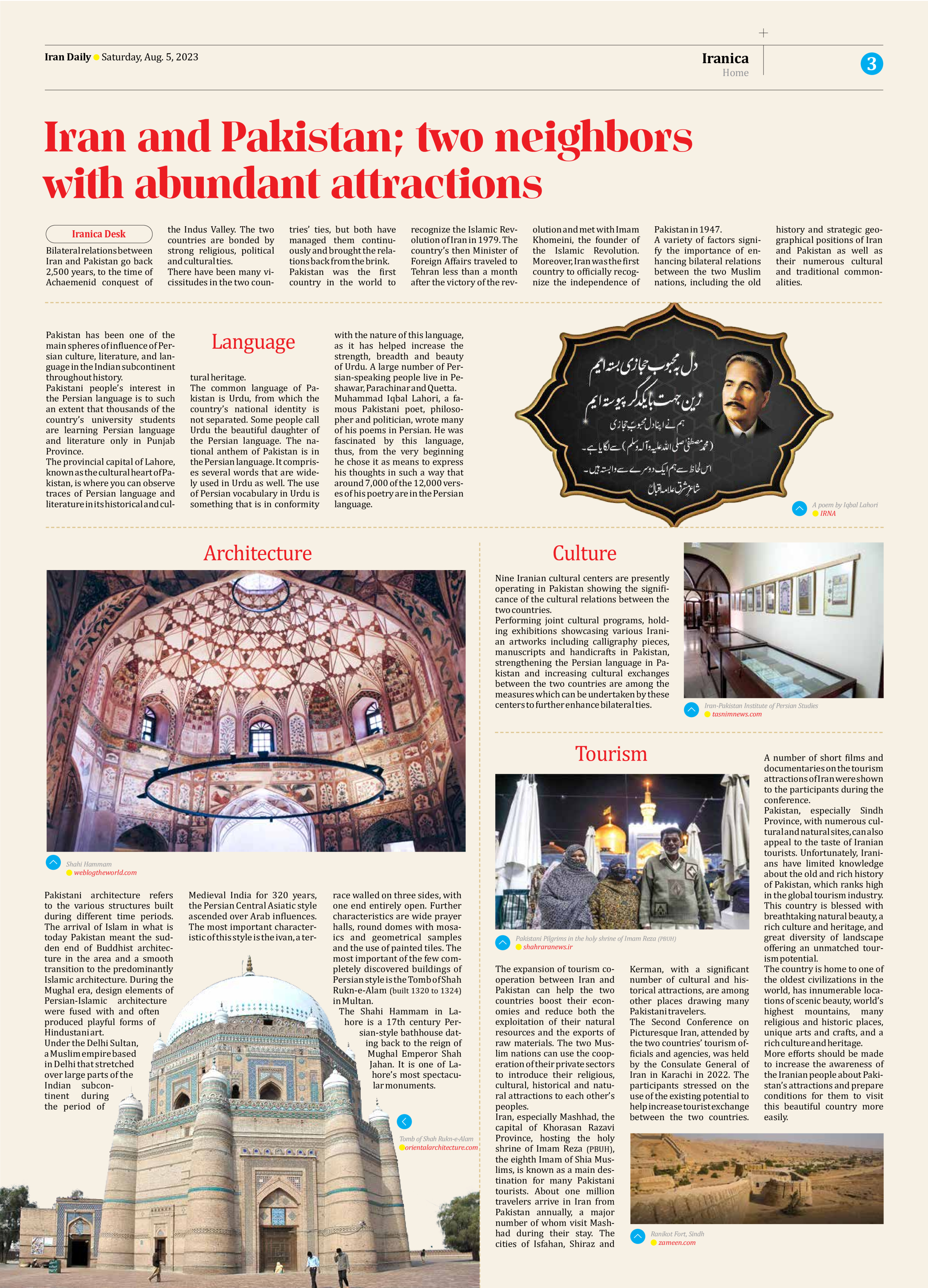
Iran and Pakistan; two neighbors with abundant attractions
Bilateral relations between Iran and Pakistan go back 2,500 years, to the time of Achaemenid conquest of the Indus Valley. The two countries are bonded by strong religious, political and cultural ties.
There have been many vicissitudes in the two countries’ ties, but both have managed them continuously and brought the relations back from the brink.
Pakistan was the first country in the world to recognize the Islamic Revolution of Iran in 1979. The country’s then Minister of Foreign Affairs traveled to Tehran less than a month after the victory of the revolution and met with Imam Khomeini, the founder of the Islamic Revolution. Moreover, Iran was the first country to officially recognize the independence of Pakistan in 1947.
A variety of factors signify the importance of enhancing bilateral relations between the two Muslim nations, including the old history and strategic geographical positions of Iran and Pakistan as well as their numerous cultural and traditional commonalities.
Language
Pakistan has been one of the main spheres of influence of Persian culture, literature, and language in the Indian subcontinent throughout history.
Pakistani people’s interest in the Persian language is to such an extent that thousands of the country’s university students are learning Persian language and literature only in Punjab Province.
The provincial capital of Lahore, known as the cultural heart of Pakistan, is where you can observe traces of Persian language and literature in its historical and cultural heritage.
The common language of Pakistan is Urdu, from which the country’s national identity is not separated. Some people call Urdu the beautiful daughter of the Persian language. The national anthem of Pakistan is in the Persian language. It comprises several words that are widely used in Urdu as well. The use of Persian vocabulary in Urdu is something that is in conformity with the nature of this language, as it has helped increase the strength, breadth and beauty of Urdu. A large number of Persian-speaking people live in Peshawar, Parachinar and Quetta.
Muhammad Iqbal Lahori, a famous Pakistani poet, philosopher and politician, wrote many of his poems in Persian. He was fascinated by this language, thus, from the very beginning he chose it as means to express his thoughts in such a way that around 7,000 of the 12,000 verses of his poetry are in the Persian language.
Culture
Nine Iranian cultural centers are presently operating in Pakistan showing the significance of the cultural relations between the two countries.
Performing joint cultural programs, holding exhibitions showcasing various Iranian artworks including calligraphy pieces, manuscripts and handicrafts in Pakistan, strengthening the Persian language in Pakistan and increasing cultural exchanges between the two countries are among the measures which can be undertaken by these centers to further enhance bilateral ties.
Architecture
Pakistani architecture refers to the various structures built during different time periods. The arrival of Islam in what is today Pakistan meant the sudden end of Buddhist architecture in the area and a smooth transition to the predominantly Islamic architecture. During the Mughal era, design elements of Persian-Islamic architecture were fused with and often produced playful forms of Hindustani art.
Under the Delhi Sultan, a Muslim empire based in Delhi that stretched over large parts of the Indian subcontinent during the period of Medieval India for 320 years, the Persian Central Asiatic style ascended over Arab influences. The most important characteristic of this style is the ivan, a terrace walled on three sides, with one end entirely open. Further characteristics are wide prayer halls, round domes with mosaics and geometrical samples and the use of painted tiles. The most important of the few completely discovered buildings of Persian style is the Tomb of Shah Rukn-e-Alam (built 1320 to 1324) in Multan.
The Shahi Hammam in Lahore is a 17th century Persian-style bathhouse dating back to the reign of Mughal Emperor Shah Jahan. It is one of Lahore’s most spectacular monuments.
Tourism
The expansion of tourism cooperation between Iran and Pakistan can help the two countries boost their economies and reduce both the exploitation of their natural resources and the exports of raw materials. The two Muslim nations can use the cooperation of their private sectors to introduce their religious, cultural, historical and natural attractions to each other’s peoples.
Iran, especially Mashhad, the capital of Khorasan Razavi Province, hosting the holy shrine of Imam Reza (PBUH), the eighth Imam of Shia Muslims, is known as a main destination for many Pakistani tourists. About one million travelers arrive in Iran from Pakistan annually, a major number of whom visit Mashhad during their stay. The cities of Isfahan, Shiraz and Kerman, with a significant number of cultural and historical attractions, are among other places drawing many Pakistani travelers.
The Second Conference on Picturesque Iran, attended by the two countries’ tourism officials and agencies, was held by the Consulate General of Iran in Karachi in 2022. The participants stressed on the use of the existing potential to help increase tourist exchange between the two countries. A number of short films and documentaries on the tourism attractions of Iran were shown to the participants during the conference.
Pakistan, especially Sindh Province, with numerous cultural and natural sites, can also appeal to the taste of Iranian tourists. Unfortunately, Iranians have limited knowledge about the old and rich history of Pakistan, which ranks high in the global tourism industry. This country is blessed with breathtaking natural beauty, a rich culture and heritage, and great diversity of landscape offering an unmatched tourism potential.
The country is home to one of the oldest civilizations in the world, has innumerable locations of scenic beauty, world’s highest mountains, many religious and historic places, unique arts and crafts, and a rich culture and heritage.
More efforts should be made to increase the awareness of the Iranian people about Pakistan’s attractions and prepare conditions for them to visit this beautiful country more easily.







